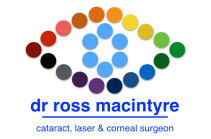Astigmatism is a condition where the eye does not focus light correctly or evenly onto the retina. This can be due to an irregular curvature of the cornea, where one side of the cornea is steeper and one side is flatter. It can also result from an irregular shape to the natural crystalline lens in the eye. It results in distorted images reaching the retina, which is seen as blurry vision.
Astigmatism can be corrected at the time of cataract surgery, by removing the cataract and placing a toric intraocular lens (IOL) or making special cuts or incisions in the cornea. Toric IOLs are specially designed lenses to correct for corneal astigmatism, and can be implanted when the cataract is removed.
A recent review article published in Ophthalmology, the journal of the American Academy of Ophthalmology, discussed the results of all studies looking at the correction of astigmatism at the time of cataract surgery. The purpose of this review was to “evaluate the benefit and harms associated with implantation of toric intraocular lens (IOLs) during cataract surgery”. This study is important as residual astigmatism after cataract surgery is a common reason that many patients have poor distance vision and require spectacles after a cataract operation.
The study looked at the outcomes after surgery, including visual acuity at distance and whether the person required corrective lenses or not. It also looked at harms caused by surgery, including any surgical complications and any residual astigmatism not corrected by the toric IOL. Included in the study were 13 randomised control trials (the best type of study) with over 700 eyes randomised to receive toric IOLs or non-toric (standard) IOLs at the time of cataract surgery.
The results showed that the distance visual acuity was better in patients who had toric IOLs compared to those who had standard IOLs, and that toric IOLs reduced the patient’s need for spectacles after the operation. It also found that using a toric IOL did not increase the risk of complications. The amount of residual astigmatism was lower in the group of patients with toric IOLs.

